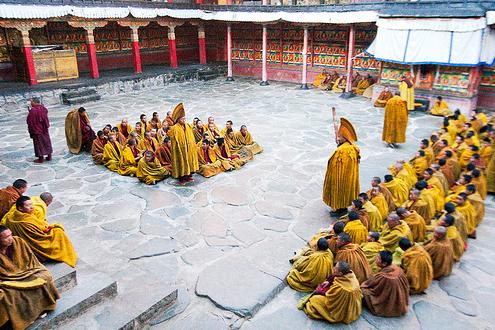
In the spring of 1970 I was granted an interview with His Holiness the Dalai Lama at his residence in Mcleod Ganj in the Indian Himalayas. He was 35 at the time and had not yet visited the West. He greeted me with a huge smile and warm handshake – forestalling my attempt at traditional Tibetan prostrations.
In the conversation that followed, he seemed almost naively keen to hear about my life, my interests and why I had decided to study Tibetan Buddhism in India and Nepal. He was enthusiastic, bordering on boisterous and showed no sign of the gravitas that developed later – when he matured into his present status as an elder statesman and custodian of the moral high ground.
I fell under the spell of his charm at my first and later meetings and became a pioneer member of the Dalai Lama fan club. I was also inspired by the lamas I met in Kathmandu and the ones who welcomed me into the fold in McLeod Ganj.
Accounts of the magic and mystery of pre-Chinese Tibet by authors like Alexandra David Neel, Lama Govinda and W.Y Evans Wentz were essential reading on the 60s and 70s hippie trail and I was one of many travellers from the developed world who were enchanted by stories about the yogi-lamas. We learned that they could walk at superhuman speeds over huge distances, for example, or survive at sub-zero temperatures by generating inner heat or at the moment of death, direct their consciousness out through the fontanelle.
We learned about the wonders of Tibetan culture – the songs, poetry and exquisite visual art – all of it rooted in an ancient Buddhist tradition. We studied the scriptures, the history books and the lives of the great sages. We realised that an entire society was organised to enable as many people as possible to live as dedicated spiritual practitioners.
We took the stories home with us and told them to our friends, relatives – anyone who would listen. Tibetan whispers spread across the globe. In San Francisco, Sydney, Auckland and all over Europe, small pockets of interest in all things Tibetan started to extend into the wider population. People set up Tibetan centres and invited lamas to come to live and teach in them.
In parallel with a fascination with the myths and legends of old Tibet, I was learning, very slowly, to meditate. Samye Ling, in the Scottish borders, was the first Tibetan meditation centre in the West and for several years I spent my free time there – commuting by overnight train from London to Lockerbie. It was hard work.
I soon discovered that Tibetan Buddhism is not all deities floating on lotus blossoms, tinkling bells and cedarwood incense. On the meditation cushion, I endured knee agony, extreme boredom and oscillations between elation and despair until I finally understood why Buddhism is known as a “science of the mind.” As my struggles gave way to what the lama Trungpa Rinpoche describes as “cool boredom” – the depth and breadth of Tibetan Buddhist experience opened up for me and practice became a firm commitment.
In the early 1970s there were roughly a dozen Tibetan meditation centres worldwide. Today there is hardly a city or a medium-size town in the developed world that does not have at least one. A Google search on Tibetan Buddhism shows 1,600,000 results. This popularity pivots partly on show business chic, with outspoken enthusiasm from celebrities like Richard Gere, Harrison Ford, John Cleese and Joanna Lumley. It also resides in the saintly image of the Dalai Lama and his steadfast refusal to endorse violence against the Chinese occupation of his homeland. But I believe the primary factor is that most Tibetan lamas are very good at teaching meditation.
The bubble burst in 1994 when the lama Sogyal Rinpoche was sued for sexual harassment by an American woman known as Janice Doe. The lawsuit was settled out of court, but it triggered an avalanche of revelations on the internet about sexual and financial misconduct by Tibetan lamas. Some of them were lunatic fringe, but many were intelligent, reflective and soberly factual.
I followed these developments with a growing sense of disillusionment. My Shangri-La version of old Tibet crumbled with the realisation that alongside the focus on spirituality, the Tibetan social order was top-down hierarchical, xenophobic, feudal and in many instances ruthless and cruel. The present Dalai Lama is the 14th in a line of reincarnations. Several of his predecessors were murdered while still young, by regents determined to hang on to power. It also became clear to me that the lamas I respected as Buddhist teachers were medieval in their attitudes towards women.
So has this awareness of the dark side driven me away from Tibetan Buddhism? I went through a period of doubt and re-appraisal, took up Hatha Yoga and became an enthusiastic practitioner. But I see no contradiction between Buddhism and acknowledgement of an imperfect world – so I now benefit from two effective mind-body disciplines.
I wish The Dalai Lama many more years of healthy life. He has acquired unique status on the world stage as the man who loves everyone – and many people nowadays accept that the joy on his face originates from a genuinely open heart.
Source: The Guardian




